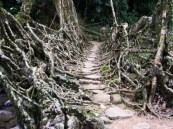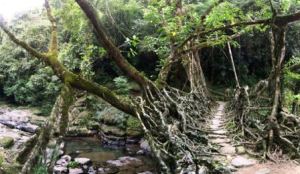 It is unfortunate how man has come to believe that it's existence has to be at the cost of nature's destruction. In the mad run for urbanization, industrialization and 'civilization', we have brought down numerous forests, flattened hills and dried lakes and rivers. Rarely do we realize that, India has a lasting legacy of man's coexistence with nature. Take the example of Meghalaya. Since as long as man has existed in these rainforests, they have not built bridges. They’ve grown them!
It is unfortunate how man has come to believe that it's existence has to be at the cost of nature's destruction. In the mad run for urbanization, industrialization and 'civilization', we have brought down numerous forests, flattened hills and dried lakes and rivers. Rarely do we realize that, India has a lasting legacy of man's coexistence with nature. Take the example of Meghalaya. Since as long as man has existed in these rainforests, they have not built bridges. They’ve grown them!
 Since the area around Cherrapunji receives the highest rainfall on earth, which means around 15 metres of rain every year, a normal wooden bridge would quickly rot. With the southern Khasi and Jaintia hills crisscrossed by swift-flowing rivers and mountain streams, human survival was difficult without bridges. On the slopes of these hills, a species of Indian rubber tree with an incredibly strong root system thrives and flourishes.The War-Khasis, a trive living in the area, soon realized that these roots can be stretched horizontally across rivers and streams, to create a solid latticework structure strong enough to be used as bridges. The practice still exists. Even today, whenever and wherever the need arises, they simply grow their bridges.
Since the area around Cherrapunji receives the highest rainfall on earth, which means around 15 metres of rain every year, a normal wooden bridge would quickly rot. With the southern Khasi and Jaintia hills crisscrossed by swift-flowing rivers and mountain streams, human survival was difficult without bridges. On the slopes of these hills, a species of Indian rubber tree with an incredibly strong root system thrives and flourishes.The War-Khasis, a trive living in the area, soon realized that these roots can be stretched horizontally across rivers and streams, to create a solid latticework structure strong enough to be used as bridges. The practice still exists. Even today, whenever and wherever the need arises, they simply grow their bridges.
In order to make a rubber tree's roots grow in the right direction - say, over a river - the Khasis use betel nut trunks, sliced down the middle and hollowed out, to create root-guidance systems. The thin, tender roots of the rubber tree, prevented from fanning out by the betel nut trunks, grow straight out. When they reach the other side of the river, they're allowed to take root in the soil. Given enough time, a sturdy, living suspension bridge is produced.
 The root bridges, some of which are over a hundred feet long, take ten to fifteen years to become fully functional, but they're extraordinarily strong - strong enough to support the weight of fifty or more people at a time. Because they are alive and still growing, the bridges actually gain strength over time - and some of the ancient root bridges used daily by the people of the villages around Cherrapunji may be well over 500 years old. While these bridges are in complete harmony with nature, they also prevent the trees from being cut. The roots help prevent soil erosion.
The root bridges, some of which are over a hundred feet long, take ten to fifteen years to become fully functional, but they're extraordinarily strong - strong enough to support the weight of fifty or more people at a time. Because they are alive and still growing, the bridges actually gain strength over time - and some of the ancient root bridges used daily by the people of the villages around Cherrapunji may be well over 500 years old. While these bridges are in complete harmony with nature, they also prevent the trees from being cut. The roots help prevent soil erosion.
 These bridges were re-discovered by Denis P. Rayen, a young Tamil boy, who arrived in Meghalaya as a member of a project evaluation team for a Delhi-based firm. He later married a Khasi girl and settled down in Cherrapunjee. Today he is the local like man responsible for changing the economy of Cherrapunjee. From being an inaccessible place in Meghalaya, it was his efforts that converted the town into a tourist destination, thereby sustaining the economy of the area. Meghalaya, today not only houses the village with highest rainfall, but also the cleanest village in Asia. What's more? A new root bridge is currently being grown and should be ready for use within a decade.
These bridges were re-discovered by Denis P. Rayen, a young Tamil boy, who arrived in Meghalaya as a member of a project evaluation team for a Delhi-based firm. He later married a Khasi girl and settled down in Cherrapunjee. Today he is the local like man responsible for changing the economy of Cherrapunjee. From being an inaccessible place in Meghalaya, it was his efforts that converted the town into a tourist destination, thereby sustaining the economy of the area. Meghalaya, today not only houses the village with highest rainfall, but also the cleanest village in Asia. What's more? A new root bridge is currently being grown and should be ready for use within a decade.
